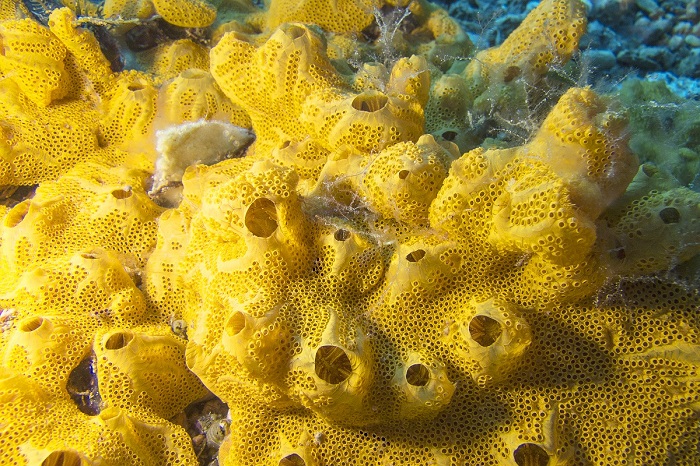Beneath the shimmering waves of our world’s oceans lies a treasure trove of marine marvels, among which the natural sea sponge stands out as a paragon of evolutionary ingenuity and ecological significance. These seemingly simple organisms, often mistaken for mere sea plants or coral formations, harbor a wealth of fascinating secrets that span from their ancient origins to their surprising utility in modern human life.
Ancient Origins and Evolutionary Marvel
Sea sponges in the ocean, belonging to the phylum Porifera, boast a lineage that stretches back over 600 million years, making them one of the oldest living multicellular organisms on Earth. Their evolutionary journey began in prehistoric oceans, where their unique porous bodies provided an advantage in nutrient-rich waters. Sea sponges lack true tissues and organs, a characteristic that sets them apart in the animal kingdom, yet their simple structure belies a complex and highly efficient system for survival.
The sponge’s porous body is a masterpiece of natural engineering. Composed of a network of tiny holes and channels, it functions as an efficient filter system, capable of processing thousands of liters of water daily. This filtration mechanism not only sustains the sponge by capturing microscopic food particles but also contributes significantly to the health of marine ecosystems by filtering out impurities and maintaining water quality.
A World of Symbiotic Relationships
One of the most intriguing aspects of ocean sea sponges is their symbiotic relationships with other marine organisms. Sponges often host a variety of microorganisms, including bacteria, algae, and fungi, within their porous structures. These symbionts can constitute up to 40% of a sponge’s biomass and play critical roles in their host’s survival. Some bacteria provide chemical defenses against predators, while others assist in nutrient acquisition.
This symbiosis is not only vital for the sponge but also benefits the broader marine environment. Sponges contribute to nutrient cycling and primary production, supporting a diverse array of marine life. In coral reefs, where sponges are abundant, their presence enhances biodiversity and resilience, making them indispensable to the health and stability of these vibrant ecosystems.
Biomedical Potential: Nature’s Pharmacy
The biomedical potential of sea sponges is another area where these fascinating creatures shine. Over the past few decades, researchers have discovered that sponges produce a myriad of bioactive compounds with significant pharmaceutical potential. These compounds, often a result of the sponge’s symbiotic relationships, exhibit properties such as anti-inflammatory, antiviral, antibacterial, and anticancer activities.
For instance, the sponge-derived compound Ara-C (cytarabine) has become a cornerstone in the treatment of leukemia and lymphoma. Another compound, manoalide, shows promise in treating inflammatory conditions and pain. The ongoing exploration of sponge-derived chemicals continues to reveal new possibilities for medical science, underscoring the importance of preserving these marine organisms and their habitats.
Environmental Indicators and Conservation Concerns
Sea sponges also serve as vital indicators of environmental health. Due to their sensitivity to changes in water quality, temperature, and pollution, sponges can provide early warning signs of ecosystem stress or degradation. Monitoring sponge populations helps scientists assess the impact of human activities such as overfishing, climate change, and pollution on marine environments.
However, this sensitivity also makes sponges vulnerable to environmental changes. The increasing threats of ocean acidification, warming seas, and habitat destruction pose significant risks to sponge populations worldwide. Conservation efforts are crucial to protect these ancient and ecologically valuable organisms. Establishing marine protected areas, regulating fishing practices, and reducing pollution are essential steps in ensuring the survival of sea sponges and the myriad of species they support.
The Sustainable Harvesting of Natural Sponges
In addition to their ecological and biomedical importance, natural sea sponges have been harvested for centuries for various human uses, from bathing and cleaning to painting and crafts. The sustainable harvesting of sponges, primarily practiced in the Mediterranean and the Caribbean, involves methods that allow the sponge population to regenerate. Divers carefully cut sponges, leaving the base intact, which enables regrowth and ensures that the sponge beds are not depleted.
This practice highlights the balance between utilizing natural resources and conserving them for future generations. Sustainable harvesting not only supports local economies but also raises awareness about the importance of marine conservation.
Guardians of the Ocean’s Depths
Natural sea sponges, with their ancient heritage, ecological roles, and biomedical potential, exemplify the intricate and often underappreciated wonders of the ocean. Their ability to filter vast amounts of water, form symbiotic relationships, and produce valuable chemical compounds underscores their significance in both natural and human contexts. As we continue to explore and understand the depths of our oceans, the humble sea sponge stands as a testament to the incredible complexity and interconnectedness of marine life. Protecting these vital organisms and their habitats is not just an ecological imperative but also a commitment to preserving the rich tapestry of life that sustains our planet.














